This post is a summary of the dissertation that Dr.-Ing. Ludwig Koch submitted in 1935 to become doctor engineer. This is what is referred to by “Koch method” in the context of learning Morse code. I will publish my commentary in another post.
You can find the scan, the transcription, and the full translation in the dedicated repository. The scan comes from the Internet Archive.
Edit: For another full translation, look here. For other summaries of the dissertation, look here, or here. I did my own summary independently of these, and before reading them.
Koch uses char/min as the unit for speed, where a character is 10.2 dots. In modern convention, we use the length of “PARIS”, that is, 50 dot, including the word separation. So, divide the char/min value by 5 to convert into word-per-minute (wpm).
Work-Psychological Study of The Process of Receiving Morse Code
Or, a new training procedure for radio operators
A. Introduction
Work psychological aims at improving the effectiveness of workers by studying how the human mind adapts to the work procedures. The profession of radio operator is chosen since their main activity is that of receiving Morse signals, which can be easily studied and quantified.
B. General Considerations
Professional radio operators are required to perfectly understand Morse code at 100 chars/min. Even with automation, man remains indispensable in certain cases. Morse code encodes characters as a series of short elements, or “dots” (·), and long elements, or “dashes” (–) tones. In standard Morse code, the proportions are:
- a: length of a dot
- b: length of a dash, equal to 3 a
- c: separation between two elements, equal to a
- d: separation between two characters, equal to 3 a

In the human mind, a concept is not the sum of its parts, but an indivisible whole, or “gestalt” in German. The reader recognizes whole words instead of deciphering each letter. The same applies to Morse code.
C. Rhythm when Sending
We first study the effect of transmission speed on the psychological process. For this, experienced operators send the sequence “B C V Q F L H Y Z X” and the exact timings are recorded. Characters have different durations — E (·) takes 1 dot, but Ch (––––) 15 — so the speed is an average.

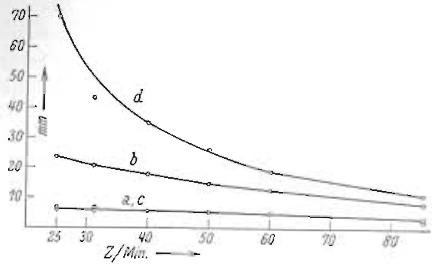 | 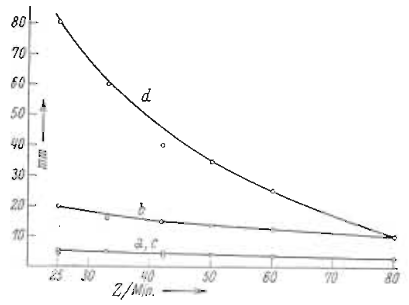 |
| Subject 1 | Subject 2 |
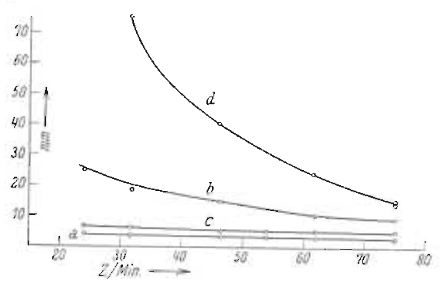 | 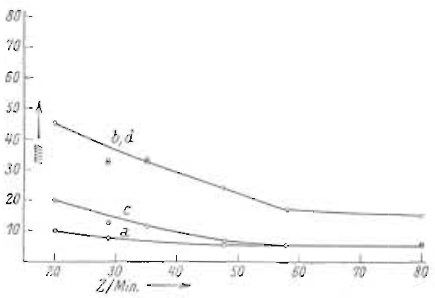 |
| Subject 3 | Subject 4 |
Average values of a, b, c, d for the 4 operators, at different speeds. Abscissa is the speed in chars/min and ordinate a, b, c and d, in a unit proportional to the duration.
At low speed, a and c are close (except in subject 4), as they should be. However, b is more than 3 a. More importantly, d is much longer than b, even though it should be equal to it. The longer pauses between the characters actually correspond to the fact that, between the pauses, characters are sent faster than the standard proportions would allow.
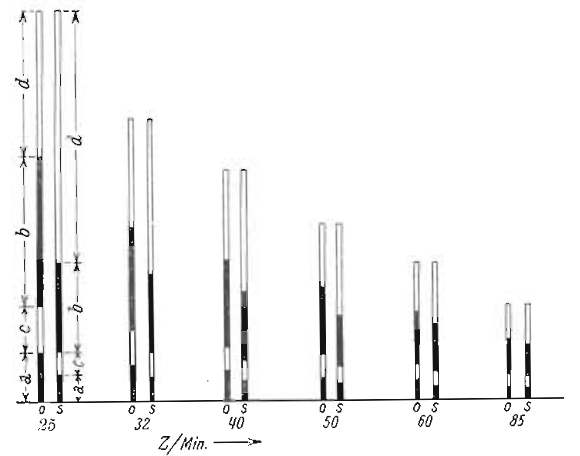 | 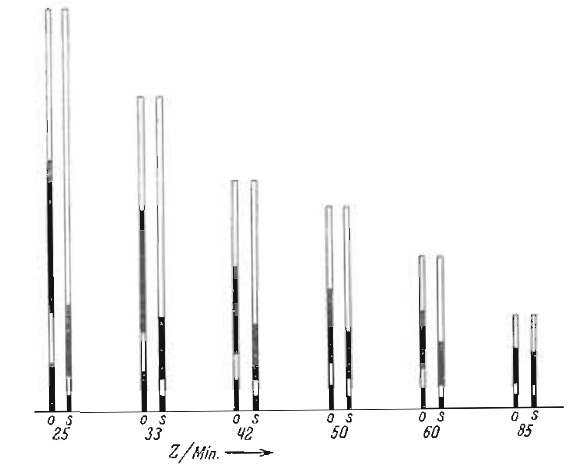 |
| Subject 1 | Subject 2 |
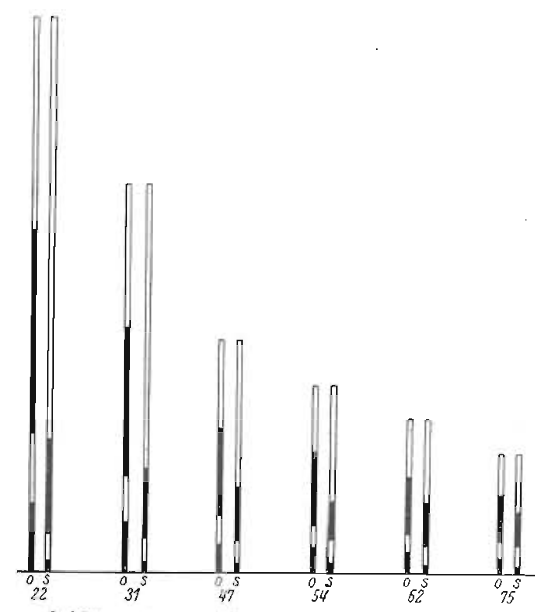 | 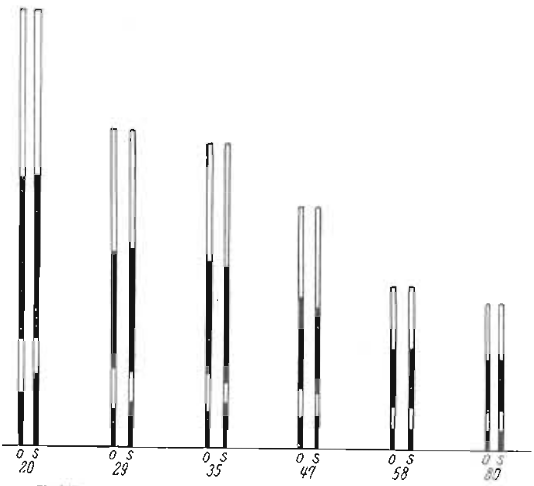 |
| Subject 3 | Subject 4 |
Lengths of a, b, c, d stacked. From the abscissa upwards, this would read as the letter “a”, including a letter pause at the end. The recorded timings are marked with “s”, and the standard timings as “o”.
Subject 4, who sent at standard proportions at low speeds, belongs to the optical learning type, and learned Morse from the visual symbols first. She can send reliably at a speed of 110-120 chars/min but cannot receive at more than 60-70 chars/min.
Thus, the operators adapt the proportions to keep the character “whole”.

To verify this, an automatic device was set to send 30 characters at the standard proportions. Experienced operators had trouble receiving the characters at low speeds. So the “whole” effect appears at a speed of 50 chars/min.
Characters themselves are not sent regularly. The table below shows the difference between standard proportions, and the effective rhythm at slow speed.
| Character | Standard | Recorded |
|---|---|---|
| L | ·–·· | · –·· |
| F | ··–· | ··– · |
| C | –·–· | –· –· |
| Q | ––·– | –– ·– |
| X | –··– | – ··– |
| Y | –·–– | – ·–– |
| K | –·– | – ·– |
| D | –·· | – ·· |
Similarly, the operator breaks the character down in subunits. In standard Morse, C is –·–·. But it is often broken into –· –· (dah dit … dah dit) or, more rarely, into –·– · (dah dit dah … dit). Other characters, such as S (···) cannot be broken down this way.
In summary, standard Morse code is only usable at a speed of 50 char/min or above.
D. Learning to Receive
I. Classical Training Procedures
a) The Analytical Method
First, the student memorizes the visual representation of the Morse code, sometimes with mnemonics. Then, they start training to receive auditory Morse code at a low speed, and gradually increase the cadence. The disadvantages of this method are:
- Having to learn the visual representation first
- Waiting for a character to finish
- No holistic effect at the beginning
- Having to switching from non-holistic to holistic sound patterns
- Having to switching from counting the dots and dashes to recognizing the sound pattern
- Adapting as the rhythm changes
b) The Sound Image method

Students learn the visual representation. When practicing reception, a longer pause is used between the individual characters, which are sent at a high speed from the beginning. Students use the pause between characters to think about what they just heard. As the speed increases, this becomes impossible, and they have to switch to immediate recognition. This shows as a plateau in the learning curve around a speed of 50 char/min. The disadvantage of this method are:
- Having to learn the visual representation first
- Thinking about the elements of the sound pattern during the long breaks.
- Having to switching from counting the dots and dashes to recognizing the sound pattern
- Adapting as the rhythm changes
II. A New Learning Procedure
To help the student directly recognize the sound pattern, the training should not teach the visual representation and should use a high speed from the start. Since the plateau is around 50 char/min, it should start with at least 60 char/min. Higher speeds make it hard to learn new characters, so just use 60 char/min.
Because of this higher starting speed, the training should start with just two characters. Other characters should be added one by one gradually as the previous ones are mastered. The speed is not increased until all characters are mastered.
The training starts with two very different characters. At first, the student is not told what the two characters are and just puts marks in the answer sheet:

This trains the student to recognize the sound pattern as a whole. Afterward, the characters corresponding to the sounds are named.
When writing the characters, a common mistake is to pause when not grasping a character immediately to try to think about it. However, this causes a cascading effects where the next characters are not grasped immediately either, or even entirely missed. To avoid this, the student should just write a dot when they do not grasp a character immediately.
The student should master these first two characters after about 10 minutes. Then, a letter is added, again without revealing which it is at first. Once the student accurately puts marks when this new character is sent, the character is revealed. This process is then repeated for each character. Once all characters are mastered, the speed can be increased.
Some characters are harder to learn. In general, X, Y, P, Q. They should be added in the last third of the training. Characters were added as L, F, C, K, R, P, X, Y, Q, D, B, G, A, N, Z, U, V, W, J, H, S, I, E, O, M, T:

Some Morse code characters are hard to distinguish, such as S (···) and H (····), U (··–) and V (···–), D (–··) and B (–···). At a higher speed, distinguishing characters composed of dash is easier: O (–––) and Ch (––––), G (––·) and 6 (–····), W (·––) and J (·–––). The characters V (···–) and B (–···) are too different to be confused. Starting the training with similar characters is not efficient: E (·), I (··), S (···), H (····).
Characters should be added gradually one by one. An experience was conducted where the characters were added several at a time: T, M, O, Ch, then E, I, S, H, then D, B, G, then U, V, W. Each addition reset the progress of the student.
Training sessions should be spread out in time instead of packed together, and should not exceed half an hour.
The experience was conducted with students, not with soldiers in training, so the schedule was not regular. In the first half-hour, trainers could learn up to 5 characters. Other characters are added more slowly. Before adding a new character, the error rate should be below 10 %. The duration of the training was limited to 24 to 28 half-hour sessions.
In addition, early practice can be helped by using a different pitch for the dots and for the dashes. The pitches are gradually brought together during the training. Merging the two pitches after the 15th or after the 20th letter makes no difference.

The characters were added as H, F, A, B, G, C, D, E, CH, L, K, I, O, T, M, P, Q, R, S, N, U, W, V, Y, X, Z (no J):

Plateaus corresponds to more difficult characters: P, X, V, Y, Q, Z. Starting the training with these characters in the first third of the training, but not at the very beginning, helps in ensuring they are mastered by the end of the training, without discouraging the student who just started.

13 to 14 year-old students have the same progression rate as adults.
Mastery of the alphabet at 60 char/min is reached in 14 hours with this method, against 7 weeks with the classical ones.
E. Aptitude Test
Those who fail to master 4 characters at a speed of 60 char/min in the first 2 half-hours never mastered all characters. So the beginning of the training also serves as an aptitude test before the candidate spent dozens of hours in training. Students should be grouped by aptitude to avoid slowing down the most apt. Some students could be impeded by slow writing, but this can be remediated with practice. Those accustomed to concentrating are best, in particular those of the acoustic imagination type. Among about 100 subjects, none of the diagnoses made on the basis of the first two half-hours led to a wrong judgment. Biegel does a similar aptitude test, but she starts at 40 char/min.
One thought on “Koch’s Dissertation on Learning Morse Code”